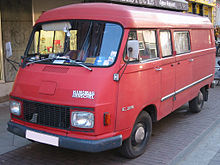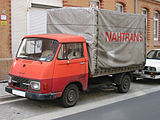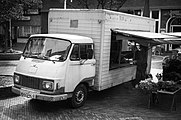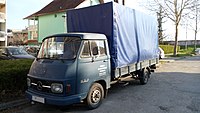Harburg transporter
The Harburger Transporter is a series of small transporters that were sold under the brand names Tempo , Hanomag , Hanomag-Henschel and most recently Mercedes-Benz . The term was not used as the official type designation.
history
The basis of the vehicle was the Matador model from Tempo in Hamburg-Harburg . After Tempo was taken over by Hanomag in 1965, the vehicles were produced as Rheinstahl-Hanomag from 1966 . In 1967 the Matador received a new body with a less rounded front and rectangular headlights. It was offered under the names Hanomag F 20, F 25, F 30 and F 35 . In 1969 Hanomag and Henschel , the two commercial vehicle manufacturers of the parent company Rheinstahl, merged. From then on, the vehicles were sold under the Hanomag-Henschel brand. Since the plant in Hamburg-Harburg was busy with the production of the vans, the models were also built from 1969 in the former Borgward plant in Bremen - Sebaldsbrück , which Rheinstahl-Hanomag had taken over from the bankruptcy estate of Borgward.
Just one year later, in 1970, Daimler-Benz took over Hanomag-Henschel. The van was now also offered as a Mercedes-Benz model. The Hanomag-Henschel and Mercedes models were largely identical in construction except for the lettering as well as the brand and type designations (“ badge engineering ”), but differences exist in technical details, for example the brakes.
For Daimler-Benz, the Harburg vans were a welcome rounding off of the existing vans range downwards; they had not been represented in this size class until then. The Mercedes vehicles were given the type designations L 206 D, L 207, L 306 D and L 307 .
The production figures of the Harburg Transporter never reached the order of magnitude of the most important competitors such as the VW Transporter or the Ford Transit . In 1975 the last vehicles were built under the name Hanomag-Henschel, under the name Mercedes-Benz production continued until 1977. Bajaj Tempo built the model in India under the name Force Matador . The successor to the market was the rear-wheel drive “Bremer Transporter” Mercedes-Benz T 1 in 1977 . A vehicle similar to the Harburger Transporter with a double tube frame and front-wheel drive was only offered again by Daimler-Benz in 1988 when it introduced the Spanish Mercedes-Benz MB 100 on the German market. However, this originally goes back to the DKW Schnellaster built under license by IMOSA in Spain .
technical features
The Harburger Transporter had a front-engine and front-wheel drive and initially a chassis made of parallel tubes. The front wheels were suspended from double wishbones with torsion bar suspension by means of longitudinally installed leaf springs, and there were crank arms at the rear. A consistently flat, low loading floor was thus possible. This differentiated it from the market leader, the VW Transporter with its rear engine . After Mercedes took over Hanomag, the swing arm (chassis) on the rear axle was replaced by a rigid axle on leaf springs in two track variants. The frame was also changed, it was angled slightly outwards at the back. The simpler construction saved manufacturing costs. Diesel and gasoline engines were available . The diesel engines initially came from Hanomag, after the takeover by Daimler-Benz, Mercedes-Benz engines with 55 or 60 hp were installed. The gasoline engines with 54 (40), later 70 HP (55 kW) were bought from the English manufacturer Austin . The permissible total weight was between 2000 kg and 3550 kg. The Harburger vans were offered as minibuses and panel vans in different heights and lengths. Platform trucks were built as single, double and triple cabins with high or low platforms with different track widths. Body builders offered sales vans and mobile homes.
Motorhome from Hymer (with broad gauge rear axle)







